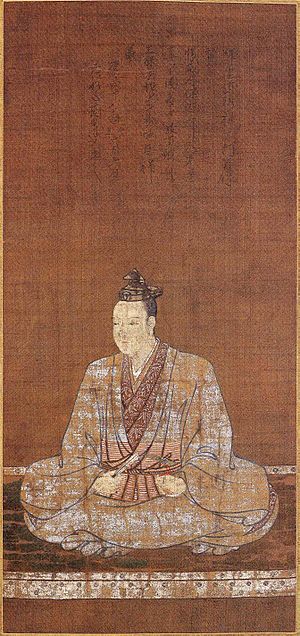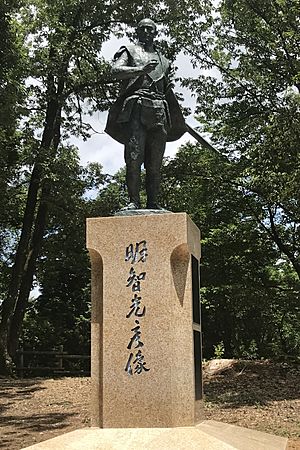Akechi Mitsuhide facts for kids
Quick facts for kids
Akechi Mitsuhide
|
|||||
|---|---|---|---|---|---|
| 明智 光秀 | |||||

Edo period painting of Akechi Mitsuhide.
|
|||||
| Lord of Kameyama Castle | |||||
| In office 1578–1582 |
|||||
| Succeeded by | Toyotomi Hidekatsu | ||||
| Lord of Sakamoto Castle | |||||
| In office 1571–1582 |
|||||
| Succeeded by | Niwa Nagahide | ||||
| Personal details | |||||
| Born | 10 March 1528 Tara Castle, Mino Province, Japan |
||||
| Died | 2 July 1582 (aged 54) Fushimi-ku, Kyoto, Japan |
||||
| Spouse | Tsumaki Hiroko | ||||
| Children | Akechi Mitsuyoshi Akechi Tama at least one other daughter |
||||
| Parents |
|
||||
| Relatives | Akechi Hidemitsu (son-in-law) Akechi Mitsutada (cousin) |
||||
| Nickname | "Jūbei" (十兵衛) | ||||
| Military service | |||||
| Allegiance | |||||
| Unit | |||||
| Battles/wars | Battle of Nagaragawa Battle of Honkoku-ji Siege of Kanegasaki Siege of Mount Hiei Kawachi Campaign Battle of Nagashino Tanba Campaign Ishiyama Hongan-ji War Battle of Tedorigawa Siege of Shigisan Siege of Yakami Castle Siege of Kuroi Castle Honnō-ji Incident Battle of Yamazaki |
||||
| Japanese name | |||||
| Kanji | 明智 光秀 | ||||
| Hiragana | あけち みつひで | ||||
|
|||||
Akechi Mitsuhide (明智 光秀, March 10, 1528 – July 2, 1582), also known as Jūbei, was a famous Japanese samurai general. He lived during the Sengoku period, a time of many wars in Japan. Mitsuhide is most known for betraying and causing the death of his powerful leader, Oda Nobunaga.
Mitsuhide first served as a bodyguard for Ashikaga Yoshiaki, who was a shōgun (military ruler). Later, he became a very successful general under daimyō (powerful feudal lord) Oda Nobunaga. Nobunaga was working to unite all of Japan.
In 1582, Mitsuhide suddenly turned against Nobunaga in an event called the Honnō-ji Incident. He attacked Nobunaga, who was unprotected in Kyoto, and forced him to commit seppuku (a ritual suicide).
After Nobunaga's death, Mitsuhide tried to become the new shōgun. However, Nobunaga's trusted general, Toyotomi Hideyoshi, quickly chased after him. Mitsuhide was defeated at the Battle of Yamazaki. His time as a leader lasted only 13 days, which is why there's a Japanese saying, mikkatenka, meaning "short-lived reign."
Mitsuhide is still a popular figure in Japanese culture today.
Contents
Early Life and Family
Akechi Mitsuhide was born on March 10, 1528, in Tara Castle, which is in what is now Gifu Prefecture. His family, the Akechi clan, was part of the larger Toki clan.
It is believed that Mitsuhide was trained to be a general from a young age. When a local lord named Saitō Dōsan was attacked by his own son in 1556, Mitsuhide chose to support Dōsan.
Serving the Shogun and Oda Nobunaga
Mitsuhide began his career serving Ashikaga Yoshiaki, who was a shōgun without a fixed home. Mitsuhide helped Yoshiaki find a new protector. He suggested that Yoshiaki ask Oda Nobunaga for help.
In 1568, Nobunaga, Yoshiaki, and Mitsuhide entered Kyoto, Japan's capital. Nobunaga helped Yoshiaki become the new shōgun.
In 1569, the Miyoshi clan attacked Yoshiaki. Mitsuhide bravely defended the shōgun and pushed back the attackers. After this, Nobunaga asked Mitsuhide to join his army, and Mitsuhide agreed.
Mitsuhide quickly became a trusted general under Nobunaga. In 1571, he was given the Sakamoto area and built Sakamoto Castle. Nobunaga usually didn't give his followers too much power, but he trusted Mitsuhide a lot. Mitsuhide was the first of Nobunaga's generals to receive his own castle.
Mitsuhide continued to fight in many battles for Nobunaga. He helped Nobunaga conquer new lands and defeat his enemies. He was also given important government jobs, like collecting taxes in Kyoto.
In 1575, Mitsuhide was sent to take control of Tanba Province. He tried to make peace with the local lords, but some, like the Akai clan, refused. Mitsuhide had to lay siege to their castle. Later, he received important titles from the Imperial Court.
However, the relationship between Nobunaga and Mitsuhide began to get difficult. In 1579, Mitsuhide captured Yakami Castle by promising peace to its leader, Hatano Hideharu. But Nobunaga broke the promise and had Hideharu executed. This upset the Hatano family, and some of them reportedly killed Mitsuhide's mother or aunt. Nobunaga also publicly insulted Mitsuhide several times, which made their relationship worse.
The Honnō-ji Incident
In 1582, Nobunaga ordered Mitsuhide to lead his army to help another general, Toyotomi Hideyoshi, who was fighting the Mōri clan. But Mitsuhide had other plans.
Instead of going west, Mitsuhide gathered his army of 13,000 soldiers and marched towards Nobunaga's location at Honnō-ji temple in Kyoto. On June 21, Mitsuhide famously declared, "The enemy is at Honnō-ji!" His army surrounded the temple and set it on fire.
Oda Nobunaga was killed during the fighting or by his own hand. Nobunaga's son, Oda Nobutada, also died after fleeing to Nijō Castle. Even though Mitsuhide didn't kill Nobunaga himself, he took responsibility for his death.
Mitsuhide's betrayal shocked everyone. He quickly tried to secure his new position. He took treasures from Azuchi castle to reward his soldiers and keep them loyal. He also tried to make friends with the Imperial Court and other powerful clans, but most refused to support him. His own relatives, like Hosokawa Fujitaka, quickly cut ties with him.
Mitsuhide's Death
Mitsuhide thought that Toyotomi Hideyoshi would be too busy fighting the Mori clan to react quickly. However, when Hideyoshi heard about Nobunaga's death, he immediately made peace with the Mori. Hideyoshi rushed his army back to Kyoto, surprising Mitsuhide.
Mitsuhide had not gained much support, and his army had shrunk to 10,000 men. Hideyoshi, on the other hand, had gathered more soldiers, reaching 20,000 men. On July 2, 1582, the two armies met at the Battle of Yamazaki.
Battle of Yamazaki
Mitsuhide set up his army south of Shōryūji Castle. He protected his right side with the Yodo river and his left side with Mount Tennōzan. Hideyoshi quickly took control of Mount Tennōzan, which gave him a strong position.
Mitsuhide's forces tried to push Hideyoshi off the mountain but failed. Hideyoshi's army then attacked Mitsuhide's front and sides. The battle lasted only two hours, and Mitsuhide's army was defeated.
Mitsuhide's men fled. Mitsuhide himself was killed while trying to escape the battle by a bandit leader named Nakamura Chōbei.
Family Members
- Father: Akechi Mitsutsuna
- Mother: Daughter of the Wakasa Takeda clan
- Wife: Tsumaki Hiroko
- Sons:
- Akechi Mitsuyoshi
- Daughters:
- Hosokawa Gracia: She married Hosokawa Tadaoki.
- Relatives:
- Akechi Mitsuharu: His cousin.
- Akechi Hidemitsu: His adopted son and son-in-law.
- Nōhime: His cousin and wife of Oda Nobunaga.
Legacy and Castles
Mitsuhide was known as a skilled builder of castles. He was involved in building or rebuilding many important castles.
Castles Built or Rebuilt by Mitsuhide
- Sakamoto Castle: This was the main base and home of the Akechi clan.
- Fukuchiyama Castle
- Kameyama Castle: A statue of Akechi Mitsuhide was built here in 2019.
- Shūzan Castle
- Kinzan Castle
- Kuroi Castle
- Shūchi Castle
- Usayama Castle
See also
 In Spanish: Akechi Mitsuhide para niños
In Spanish: Akechi Mitsuhide para niños
- People of the Sengoku period in popular culture





